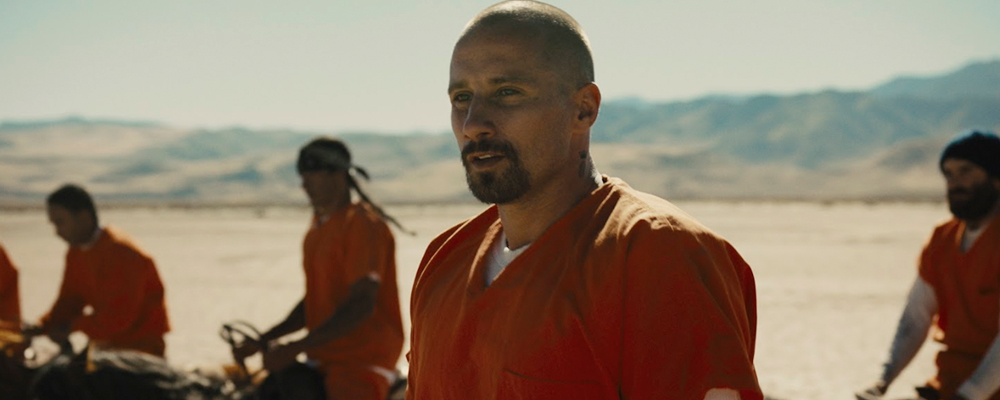Matthias Schoenaerts on Taming Wild Horses and Emotions in ‘The Mustang’
Alci Rengifo
Matthias Schoenaerts has made a career of conveying intense, palpable characters in a wide range of genres. For “The Mustang” the Belgian actor becomes a man imprisoned physically and emotionally, finding some redemption through learning how to break and ride wild horses. This poetic yet fierce drama by Laure de Clermont-Tonnerre (herself an actress of much experience) contrasts the confined feeling of a jail cell with the wide open spaces of rural Nevada. Schoenaerts plays Roman Coleman, a convict who gets by working in an outdoor maintenance program while dealing with his daughter Martha (Gideon Adlon), who is pregnant and plans to settle down with her boyfriend. Roman is still haunted by the horrible crime that drove them apart. A veteran horse trainer, Myles (Bruce Dern), recruits him for a prison rehabilitation program where inmates learn to break wild mustangs and then parade them for auction. Roman finds it difficult at first, but with the help of a fellow, more experienced inmate, Henry (Jason Mitchell), he begins to learn the art of taming the animals. But he must also tame his inner demons and the pull of prison’s more brutal lifestyle.
As with his work in films big and small like “Rust and Bone,” “The Danish Girl” and “Red Sparrow,” Schoenaerts is never less than convincing as the dark yet sensitive Roman. With his natural yet quiet demeanor, he fits perfectly with Clermont-Tonnerre’s eloquent vistas and contemplative writing. This is a film full of intensity in how characters are forced to survive together, confined, and only the mustangs seem to be truly free.
Schoenaerts sat down with Entertainment Voice to share about his experience in making this film, which is one of the year’s first great indies.
“I was attached to the project two and a half years before it filmed,” said Schoenaerts, “We had a chance to visit three maximum security prisons, to spend a lot of time with inmates. That definitely helped me create the emotional silhouette of the character. Even though we think we know what that space is, to be incarcerated for so long, it’s still a pretty mysterious and unknown territory.” The actor spoke with prisoners specifically about how they felt and what their inner worlds are like behind bars. “To hear them vocalize all that was an enormous source of inspiration.”
But when it came to dealing with horses, Schoenaerts admits he had even less experience. “Eh, when it comes to horses, I knew nothing, nothing at all. I wasn’t even a rider. I had to start from scratch. I had to completely learn from scratch. That was an intense schooling program, as you can imagine,” he says with a light laugh. “We had a wild horse, a semi-wild one and a completely trained one for the different stages in the movie. We had three horses that looked the same but were totally different.”
There were no close calls when shooting with his equestrian co-stars but “there were some sketchy moments,” admits Schoenaerts when discussing a particular scene where prisoners must bring a group of mustangs into the prison’s kitchen during an intense storm. “We had to have 10 to 15 horses in a kitchen with flickering lights and if something goes wrong in there I mean there’s gonna be some carnage. That was the one day I was not really comfortable, I was like ‘I really wanna get out of here man, I don’t feel good about this.’”
Getting into how an actor can relate with a character, possibly from familiar traits, Schoenaerts says, “There are always some aspects of a character you identify with. I always call that ‘the secret garden of the artist.’ There are always things you can relate to, identify with. What those elements are the secret garden. It’s part of one’s intimacy. Everybody knows about loss, guilt, alienation, isolation, sadness. These are all elements people to a greater or lesser extent can relate to.”
“We spoke a lot before we started shooting,” says Schoenaerts about his working relationship with director Clermont-Tonnerre. “Obviously we spent days together, always talking, going to these prisons, discussing what we just lived. Then there’s also the cinematic execution which we discussed a lot, like what is the visual tone of the film, what is the visual language, the style and the texture that we are looking for. We were always synchronizing and trying to understand each other. We found a sense of harmony that manifested itself when we started shooting.”
Set in a rural world of wide desert spaces and storm clouds, Schoenaerts believes “The Mustang” retains a universal power and message. “It’s very relevant. It talks about the absolute possibility of transformation and change. It starts with the willingness of the individual to change. Then it’s about support and kindness and tenderness. Then it manifests itself in how this individual relates to the animal, an animal that symbolizes sincerity and non-judgmental interaction, and yet it also symbolizes this brutal force of nature. It’s a magnificent animal that is so cinematic.”
Schoenaerts’s choice of projects has been eclectic, with titles like “Bullhead” and “Far from the Madding Crowd.” He is currently shooting a more music-oriented film, “The Sound of Philadelphia,” with French director Jérémie Guez. But having reportedly been offered roles before in the ongoing behemoth of superhero films, he admits he is ready to try bigger things. “I don’t exclude anything. I like different experiences. Now I want to try something else again, I would love to do the antagonist in a good superhero movie, it would be super fun. I just didn’t feel ready before. Now I am opening up to that. There’s no exclusion of any kind. It’s just keeping the experience alive and trying to alternate and be playful about things.”
“The Mustang” opens March 15 in select theaters.





